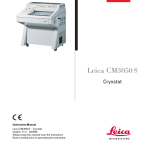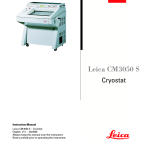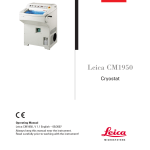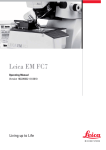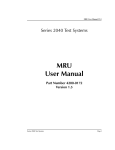Download Manual_MTC_07-2010
Transcript
OPERATING INSTRUCTIONS Cryostat MTC INS2200GB 07-2010-04 Instructions – MTC 1 Instructions – MTC 2 CONTENTS 1. INTENDED USE ............................................................ 4 2. SYMBOLS ............................................................ 4 3. SAFETY NOTES ............................................................ 4 4. COMPONENTS ............................................................ 8 5. SPECIFICATIONS ............................................................ 9 6. UNPACKING AND INSTALLATION ............................................................ 10 7. INITIAL OPERATION ............................................................ 12 8. OPERATION OF MICROTOME ............................................................ 19 9. OPERATION OF CRYOSTAT ............................................................ 29 10. CLEANING AND MAINTENANCE ............................................................ 32 11. SERVICE ............................................................ 34 12. OPTIONAL ACCESSORIES ............................................................ 35 13. WARRANTY ............................................................ 36 14. DISPOSAL ............................................................ 36 Instructions – MTC 3 1. INTENDED USE The bench top cryostat MTC is intended for rapid freezing and cutting thin sections of frozen specimens for professional use in routine and research laboratories in the fields of biology, medicine and industry. The system of knife advance operates very reliable from 1 to 25 µm with trimming function up to 25 µm. The MTC is an easily transportable instrument with space-saving design which makes it the perfect alternative for locations with limited space, increased mobility requirements or simply as an economic backup instrument. 2. SYMBOLS Dangers, warnings and cautions are marked by this symbol i Special instructions regarding the operation of the instrument are marked by this symbol 3. SAFETY NOTES The SLEE Medical bench top cryostat MTC is provided with the following safety features: MTC Hand wheel stop Finger protection for Knife- and blade-holder • • The institution which owns the unit and the persons working with the unit, servicing or repairing it have the responsibility for a hazard-free use. Instructions – MTC 4 3.1 Hand wheel stop Always use the finger protection with the knife-/blade holder and put hand wheel in stop position • before working with the knife or specimen • before changing the specimen • during break time The hand wheel can be stopped in any position. For this purpose move the stop lever towards the centre. For releasing the stop please turn the lever towards the outside again. Hand wheel stop released. Movement. Hand wheel stop activated. No movement. Instructions – MTC 5 3.2 FINGER PROTECTION Use the finger protection always • Before you start any work with the knife or specimen • Before changing the specimen • During work break Finger protection released. Finger protection activated. Instructions – MTC 6 3.3 ELECTRICAL POWER CONNECTION Do not use any extension lead. Make sure that electric power is constant: • This should be examined during installation of the unit by a competent person • Use a dedicated fuse for the unit • Do not connect another unit to the same power circuit. • Before turning on the instrument, check if the voltage of the mains supply is identical with the name plate of the unit 3.4 WORKING WITH KNIVES AND DISPOSABLE BLADES Microtome knives and disposable blades have extremely sharp edges and this can lead to injuries. Please be extremely careful when handling microtome knives and disposable blades. Do not place microtome knives or disposable blades at unsecured areas. Never position microtome knives or disposable blades with the sharp edge pointing upwards. Store blades in a covered container. Use a container that has guides to hold the blades rigid. Never try to catch a falling microtome knife. Always insert the specimen first and then the microtome knife or disposable blade. To avoid compression or knife marks, ensure that the blade is clean. Instructions – MTC 7 4. COMPONENTS The SLEE bench top cryostat MTC is provided with the following standard components: MTC Basic unit with refrigeration system • Manual rotary microtome • Operation manual • 2x Specimen holder (1x Ø 22mm; 1x Ø 35 mm) clear-cut Brush Anti-roll plate Ready to use • • • 1x Bottle cryostat low temperature oil • 4x 100 ml CryoGlue embedding medium • 1 Box of disposable blades (50 pcs.) or 1 steel knife (12 cm C-profile) • Set of Allen keys • Instructions – MTC 8 5. SPECIFICATIONS Operating temperature range +10 °C to +25 °C Section thickness setting range 1 - 25 µm Section thickness selection MTC 0 – 10 µm in 1-µm-steps 10 - 25 µm in 5-µm steps Horizontal specimen advance 25 mm Vertical specimen stroke 52 mm Dimensions and weight 550 mm x 730 mm x 470 mm [width x depth x height] 77 kg Weight without accessories Specimen orientation, horizontal 8° Specimen orientation, vertical 8° Specimen orientation, z-axis 360° Trimming thickness 0 – 10 µm in 1-µm-steps 10 - 25 µm in 5-µm steps Instructions – MTC 9 6. UNPACKING AND INSTALLATION 6.1 UNPACKING THE INSTRUMENT Remove the upper wooden cover. Remove the upper supporting foams. Lift the instrument out of the wooden transportation case. For repacking use the original cases. Keep the packing material. Place the instrument onto the selected bench. 6.2 INSTALLATION SITE REQUIREMENTS The site for installation should meet the following requirements: • Placement onto a plane, vibration-free surface. • A maximum ambient temperature of 25 °C. • Convenient and unobstructed access to the hand wheel. • No direct sunlight into the cooling chamber. • A minimum distance between wall and rear of the instrument of 10-20 cm should be guaranteed. • A free ventilation of fresh air from the left-hand and right-hand side of the instrument should be guaranteed. 6.2 INSTALLATION For opening the chamber push the window to the top. Remove the transport security underneath the specimen holder and position the waste tray. After installation, wait at least 4 hours before switching the instrument on. Failure to comply may result in severe damage to the instrument. Instructions – MTC 10 6.3 COLLAPSIBLE HANDWHEEL LEVER The instrument is delivered with a ready to use hand wheel lever that is folded away for transport reasons. • Before you start any work unfold the hand wheel lever by simply pulling the lever into a horizontal position. • For folding the lever back, pull the horizontally orientated lever and fold it away. Hand wheel lever in folded position. Hand wheel lever unfolded. Instructions – MTC 11 7. INITIAL OPERATION 7.1 MAIN DISPLAY AND CONTROL PANEL Cooling unit and cryochamber settings can be operated with the control panel on the front side of the instrument. MTC Control Panel 7.2 LED SIGNALS ON Activated cooling, the compressor of the cooling unit is running. Flashing Programming phase (flashing with LED ON The fan is running. Flashing Programming phase (flashing with LED Instructions – MTC . . 12 ON The defrost is enabled. Flashing Drip time in progress. ON The fast freezing cycle is enabled. Instructions – MTC 13 7.3 SETTING OF CRYOSTAT TEMPERATURE Press for change of the cryostat temperature. LED starts blinking and a new target temperature can be set. Set new target temperature by pressing and . LED starts flashing and setting of new time, day and weekly holiday is possible. Press or wait for 10 seconds to store the new target temperature. Instructions – MTC 14 7.4 SETTING OF TIME, DAY AND WEEKLY HOLIDAYS Press for more than 3 seconds. LED switches ON and the current time is displayed. Hur (hour); Min (minute); dAY (day) Press to enter the setting mode for time, day and weekly holiday. LED starts flashing and setting of new time, day and weekly holiday is possible. Press and Press to go to the next value. Press and minutes. to set the current hour. to set the current to go to the next value. Press and Press to go to the next value. Press Press to set the first weekly to set the second weekly to go to the next value. Press and holiday. Press to set the current day. to go to the next value. Press and holiday. Current hour (0...23 h) Min Current hour (0...59 min) Press Press and holiday. Hur to set the third weekly to go to the next value. dAY Current day (Sun...SAt) Hd1 First weekly holiday (Sun...SAt) To disable first weekly holiday, set it to “nu” (not used). Hd2 Second weekly holiday (Sun...SAt) To disable second weekly holiday, set it to “nu” (not used). Hd3 Third weekly holiday (Sun...SAt) To disable third weekly holiday, set it to “nu” (not used). Press and or wait for 15 seconds to return to the main menu. Instructions – MTC 15 7.5 AUTOMATIC DEFROST SETTINGS Press for more than 3 seconds. LED switches ON and the current time is displayed. Press to enter the setting mode for automatic defrost cycles. LED starts flashing and setting of new defrost time is possible. Press and to set the time for automatic defrost on working days. Press to go to the next value. Ld1...Ld8 Automatic defrost starting time on workdays (0...23 h 50 min.) These values define the time for automatic defrost cycles on working days. Up to eight times can be set. To disable a defrost cycle, set it to “nu” (not used). (e.g. If Ld1 is set to 12.4, the first defrost cycle will start on working days at 12:40 h) Press and to set the time for automatic defrost on holidays. Press to go to the next value. Sd1...Sd8 Automatic defrost starting time on holidays (0...23 h 50 min.) These values define the time for automatic defrost cycles on working days. Up to eight times can be set. To disable a defrost cycle, set it to “nu” (not used). (e.g. If Sd2 is set to 13.3, the second defrost cycle will start on holidays at 13:30 h) Press and or wait for 15 seconds to return to the main menu. Instructions – MTC 16 7.6 POWER SAVING SETTINGS Press for more than 3 seconds. LED switches ON and the current time is displayed. Press to enter the setting mode for power saving settings. LED starts flashing and setting of new power saving time and temperature is possible. Press and to set the time for energy saving cycles on working days. Press to go to the next value. Press and to set the duration of energy saving cycles on working days. Press to go to the next value. and to set the time for energy Press saving cycles on holidays. Press to go to the next value. Press and to set the duration of energy saving cycles on holidays. Press to go to the next value. Instructions – MTC ILE Energy Saving cycle on workdays (0...23h 50 min.) This value defines the time at that during working days an energy saving cycle will be started. dLe Energy Saving cycle length on workdays (0...24h 00 min.) This value defines the duration of an energy saving cycle during working days. ISE Energy Saving cycle on holidays (0...23h 50 min.) This value defines the time at that during holidays an energy saving cycle will be started. dSE Energy Saving cycle length on holidays (0...24h 00 min.) This value defines the duration of an energy saving cycle during holidays. 17 Press and to set the temperature increase for energy saving cycles. Press to go to the next value. HES Temperature increase for Energy Saving Cycle This value defines the temperature increase to the target (working) temperature for the energy saving cycle. (e.g. a cryostat temperature has been set to -25 °C as described in 7.3 and the energy saving cycle has been set to an increase of 15 °C. The energy saving temperature will be -10 °C. Press and or wait for 15 seconds to return to the main menu. 7.7 LIGHT IN CRYOCHAMBER Press to activate the light in the cryochamber. LED switches ON and the current time is displayed. Press again to switch off the light. 7.8 MANUAL DEFROST Press for more than 3 seconds to activate manual defrost. LED switches ON and the instrument is defrosting. The instrument will automatically return to normal cooling after defrost. Instructions – MTC 18 8. OPERATION OF MICROTOME 8.1 INSERTION AND ORIENTATION OF KNIFE Activate hand wheel lock. Loosen the knife fixation by turning two screws in the front of the knife holder counter clockwise Remove/Insert knife Adjust knife height by turning the wheels on the left and right side of the knife holder base. Tighten the knife fixation by turning the two screws in the front of the knife holder clockwise. Release hand wheel lock for cutting. Loosening of knife fixation and insertion of new knife. Fixation and height adjustment of knife. Instructions – MTC 19 8.2 INSERTION AND ORIENTATION OF DISPOSABLE BLADE Activate hand wheel lock. Remove finger protection. Loosen the blade fixation by turning the right lever counter clockwise. Remove/Insert blade from one side. Tighten the blade fixation by turning the right lever clockwise. Loosening of blade fixation and insertion of new blade. Horizontal orientation For adjustment of cutting area of the blade, loosen the blade holder fixation by turning the left lever on the blade holder base counter clockwise. Fixation of blade. (see figure on following page) Set new cutting area by moving the blade holder to the left or to the right. Tighten the blade holder fixation by turning the right lever on the blade holder base clockwise. (see figure on following page) Release hand wheel lock for cutting. Loosening of blade holder fixation and horizontal orientation of blade holder Instructions – MTC 20 Adjustment of Cutting Angle For adjusting the cutting angle of the blade, loosen the blade holder fixation by turning the left lever on the blade holder base counter clockwise. Set new angle for cutting by manual tilting the blade holder. A tilt towards the object holder increases the cutting angle, a tilt away from the object holder decreases the cutting angle. A scale on the right side of the blade or knife holder helps to find the correct orientation. Tighten the blade holder fixation by turning the right lever on the blade holder base clockwise. Loosening of blade holder fixation and adjusting new cutting angle (increased cutting angle). Release hand wheel lock for cutting. Fixation of blade holder with increased cutting angle. Instructions – MTC 21 8.3 SPECIMEN MOUNTING The instrument is equipped with 6 freezing positions. In order to prepare a specimen for sectioning, place the specimen holder on a freeze point, add some drops of embedding medium (e.g.GSV1) on the holder and carefully press the object on top. Wait until the object is frozen (mat surface or pressure). 8.4 INSERTION OF OBJECT HOLDER Turn hand wheel to its highest position and activate the hand wheel stop. Release the object holder fixation by turning the right fixation lever counter clockwise. Remove/Insert object holder. Tighten the object holder by turning the right fixation lever clockwise. Release of object holder fixation; removal and/or insertion of object holder. Instructions – MTC 22 8.5 SPECIMEN ORIENTATION ADJUSTMENT Turn hand wheel to its highest position and activate the hand wheel stop. For orientation of the specimen, open the fixing lever by turning the fixation lever to the left. Orientate the specimen by manually moving the lever into the respective position. Close the orientation fixation by turning the fixation lever to the right. Release hand wheel lock for cutting. Opening of orientation fixation lever. Manual orientation of object holder upwards/downwards and left/right. Fastening of orientation fixation. Instructions – MTC 23 8.8 THICKNESS ADJUSTMENT FOR TRIMMING To change the cutting thickness, turn the knob in the front of the blade or knife holder to the respective position as indicated. Manual thickness adjustment for trimming. 8.9 THICKNESS ADJUSTMENT FOR CUT To change the cutting thickness, turn the knob in the front of the blade or knife holder to the respective position as indicated. Manual thickness adjustment for cutting. Instructions – MTC 24 8.10 COARSE ADVANCE OF BLADE/KNIFE HOLDER Turn hand wheel on the left-hand side of the instrument counter clockwise to move the blade or knife holder towards the specimen. Turn hand wheel on the left-hand side of the instrument clockwise to move the blade or knife holder away from the specimen. Coarse advance of blade or knife holder. Backward movement of blade or knife holder. Instructions – MTC 25 8.11 MANUAL CUTTING Release hand wheel stop. Release the finger protection. For cutting turn the hand wheel on the right side of the instrument evenly clockwise. A counter clockwise movement of the hand wheel will also result in cutting and incremental advance of the specimen. For trimming of specimen, select a higher cutting thickness with the knob on the front side of the blade or knife holder. Cutting of specimen. Select cutting thickness by turning the knob on the front side of the blade or knife holder to the respective position. Turn hand wheel until some even sections have been obtained. Clean the microtome knife or disposable blade (always away from the cutting edge) with a cold brush. Position anti-roll plate onto the microtome knife or disposable blade and cut. If necessary readjust the height of the guide plate. Selection of trimming and cutting thickness. Leave hand wheel with handle at its lowest point (specimen holder underneath the microtome knife or disposable blade). Transfer the section onto a slide. i Leave brush always in the chamber to keep it cold. Instructions – MTC 26 8.12 ANTI-ROLL PLATE Each instrument is equipped with an antiroll plate. To adjust the height of the anti-roll plate turn the wheel to the left or right. For pick up of the samples turn the antiroll plate side wards with the help of the knob. Height adjustment of anti-roll plate. i For height adjustment of the anti-roll-plate it is recommended to adjust the correct height during cutting. Instructions – MTC 27 8.13 TIPS AND TRICKS It is common knowledge that the temperature of the cryostat plays an important role in the quality of the tissue sections obtained. Each type of tissue needs a different temperature as shown in the following list. The temperature ranges indicated in the table below are approximate values and may require adjustments for individual tissues. Type of Tissue Recommended temperature range at the knife or blade edge [°C] Bone marrow -16 to -25 Brain -7 to -10 Breast with fat -25 to -30 Breast without fat -16 to -20 Cartilage -13 to -20 Fat -30 to -40 Heart -20 to -25 Intestinal -13 to -20 Kidney -13 to -20 Larynx -13 to -16 Lip -10 to -20 Liver -7 to -13 Lung -13 to -20 Lymph-Node -13 to -20 Lymphatic -13 to -20 Lymphoid -13 to -20 Muscle -13 to -20 Nose -13 to -20 Rectal -13 to -20 Scrapings -16 to -25 Skin with fat -16 to -25 Skin without fat -10 to -16 Spleen -7 to -10 Testicle -10 to -13 Tongue -13 to -20 Uterine-Curettings -7 to -10 Instructions – MTC i For tissue, which has to be cut considerably below normal chamber temperature (e.g. fatty tissues) and in order to avoid cooling artefacts, an additional bench top CO2 freezer is available. Exceptionally freezing spray can be used. 28 9. OPERATION OF CRYOSTAT 9.1 UVC DISINFECTION [only applicable to instruments equipped with this feature] UV-C radiation at 254 nm has an intense germicidal effect. Microorganisms, such as viruses, bacteria, fungi and yeasts are effectively destroyed in the area accessible to UV light without the addition of chemicals. The cryostat MTC can be equipped with an UVC light source that is activated and deactivated manually by pressing UV . i For safety reasons UV-C light will be switched off upon opening of the lid of the cryochamber. The UV-C disinfection will not be aborted and the UV-C light switches on upon closure of the cryochamber lid. For deactivation, please press UV . 9.3 HEAT EXTRACTOR For a more rapid freezing process with improved structural preservation of tissues and a flattened block surface, the instrument is equipped with an heat extractor. Apply the heat extractor on top of the specimen during the freezing process. Heat extractor for four freezing positions. i Use of the heat extractor can lead to changed orientation of the specimen in the frozen block, especially for smaller samples. If precise orientation of the specimen is required, the freezing procedure should be performed without the heat extractor. Instructions – MTC 29 9.4 AUTOMATIC/MANUAL DEFROST For optimum performance of the cooling unit a low thermal contact resistance at the cooling lamella is required. Upon frequent use of the instrument moisture will condensate and freeze on the surface of the cooling lamella and increase the thermal contact resistance. To avoid further build-up of the ice film, automatic defrosting cycles can be performed. During an automatic defrost or an manual activated defrost hot gas from the cooling system is pressed through the evaporator. All ice which has built up is melted, the water drops into a heated tray below of the evaporator and from there it flows into a tray with hot tubes and evaporates inside the instrument. The defrost will last till the system reaches a temperature of +20°C on the evaporator. The temperature inside the chamber is still below 0°C so that samples can be left on the cooling bar. i The default setting for automatic defrost is set to 00:00 o’clock (midnight) each day. For changing the settings, please refer to section 7.4. Instructions – MTC 30 9.5 COMPLETE DEFROST OF THE INSTRUMENT It is highly recommended to completely defrost the instrument at least every 6 months. If the instrument is used regularly in warm tropical climate a more frequent complete defrost might be necessary. Turn hand wheel to its highest position and activate the hand wheel stop. Remove samples and tools from the cryochamber. Switch off the instrument Place a container at the flexible outlet hose to collect all the melt water. Remove the rubber plug at the right backward of the cryochamber. Dry the inside of the cryochamber completely. Switch on the instrument. Flexible hose to drain out melt water. Removal of rubber plug in cryochamber. i Before starting a complete defrost of the instrument, assure that all samples have been removed from the cryochamber. Before switching on the instrument ensure that the instrument is completely dry, otherwise ice built up can damage mechanical parts. Instructions – MTC 31 10. CLEANING AND MAINTENANCE 10.1 CLEANING The recommended frequency of cleaning of the cryostat chamber depends on how frequently the instrument is used. Wear protective clothing and disposable gloves according to Good Laboratory Practices. Please take note of the safety aspects of the instrument. Do not use acetone or xylene for cleaning the unit. Only use alcoholic media. Never spray or use cleaning medium directly onto the touch panels. 10.2 RECOMMENDED MAINTENANCE AND SERVICE SCHEDULE Remove frozen section waste from the cryostat chamber after every day of usage. Daily Disinfection if necessary. Cleaning of blade holder (see section 10.3). Weekly Cleaning of window. Monthly Check of temperature sensor in cryochamber. Cleaning of cryostat ventilation (see section 10.4). Yearly Complete Service (performed by authorized SLEE service technician) • check of all functions • complete defrost • removing of microtome • oiling of movable parts • check of cooling system • check of driving system • complete disinfection / cleaning / drying Instructions – MTC 32 10.3 CLEANING OF BLADE HOLDER Turn hand wheel to its highest position and activate the hand wheel stop. Release the blade fixation by turning the fixation lever counter clockwise. Remove blade fixation plate. Clean blade holder with a brush or dry paper cloth. Reassemble blade fixation plate and fasten blade fixation. Release hand wheel lock for cutting. Loosening of blade fixation and removal of fixation plate. Cleaning of blade holder. Reassembly and fastening of blade fixation. Instructions – MTC 33 10.4 CLEANING OF CRYOSTAT VENTILATION During usage of the instrument dust will deposit on the ventilation of the cooling unit. This can negatively affect the cooling performance of the instrument. Remove dust from the ventilation grill on the right and left side of the instrument with a regular vacuum cleaner monthly. Cleaning of cryostat ventilation with vacuum cleaner. 11. SERVICE Internal components should only be serviced by technicians authorized by SLEE. If technical service or spare parts are necessary, please contact your local SLEE Medical distributor. Please have the following information available: • Complete contact details • Type of instrument and serial number • Place of instrument and name of user • Purpose of service call • Delivery date of the unit If it is necessary to return the instrument, it must be cleaned and disinfected before delivery. It must be returned in its original packing. If the instrument or parts thereof are sent back in a dirty or non-disinfected condition, SLEE reserves the right to return the parts to the debit of the customer. Instructions – MTC 34 12. OPTIONAL ACCESSORIES Standard Knife Holder #10146000 Disposable Blade Holder (low profile) #10147000 Disposable Blade Holder (high profile) #10148000 UV disinfection #10169000 Object holder (Ø 22 mm) #30000002 Object holder (Ø 35 mm) #30000000 Cork plate (100 pcs.; Ø 20 mm) #30001001 CryoGlue embedding medium (4x 100 ml) #30001100 clear-cut Brush #30001030 Anti-roll plate #30001006 Disposable blade (low profile; 50 pcs.) #28407000 Disposable blade (high profile; 50 pcs.) #28408000 Freezing spray (173 g) #30001010 Cryostat low temperature oil (50 ml) #30001011 Bench top CO2 freezer #10100002 Instructions – MTC 35 13. WARRANTY SLEE Medical GmbH guarantees that the product delivered has been subjected to a comprehensive quality control procedure, and that the product is faultless and complies with all technical specifications and/or agreed characteristics warranted. SLEE Medical GmbH guarantees that the instrument is manufactured under an ISO 9001 quality management system. Unauthorized modification or repair by third party persons will void the warranty. Only original SLEE spare parts must be used. Guarantee claims can be put forward only if the instrument is used according to this manual and for the purpose described. Mistakes and errors which occur because of improper use cannot be accepted. 14. DISPOSAL The instrument or parts of the instrument must be disposed of according to existing local applicable regulations. SLEE medical GmbH Carl-Zeiss-Str. 49 55129 Mainz / Germany Tel. +(49) 61 31/9 58 71-0 Fax +(49) 61 31/9 58 71-722 [email protected] http://www.slee.de Instructions – MTC 36









































